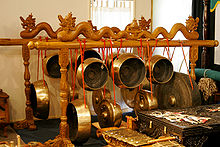Gamelan gambuh
| Music of Indonesia | |
|---|---|

Kempul gongs from Java
|
|
| Genres | |
| Specific forms | |
| Regional music | |
Gambuh is an ancient form of Balinese dance-drama. It is accompanied by musicians in a gamelan gambuh ensemble.
Gambuh is one of the oldest surviving forms in Balinese performing arts, dating to the late Majapahit era (ca. 15th century) with very little known change since this time. Emiko Susilo writes, "when the dance-dramas of Majapahit came to Bali, they had the new task of preserving the tradition of a fallen dynasty" (emphasis in original). It also introduced a new element of narrative to Balinese performing arts that influenced other forms of dance-drama on the island, such as topeng masked dance and arja opera. For centuries it was supported by patronage at the royal courts of Bali's aristocracy, during which it achieved its greatest heights of sophistication. As the courts fell apart in the bloody wars with the Dutch, this support evaporated and much of the art of gambuh was lost. Like the many other arts that formerly depended on royal patronage, gambuh found some community support by playing for temple ceremonies.
Gambuh is now nearly extinct. In 1997, Susilo observed, "In total there are perhaps only four groups that perform in the Gambuh style." It is unpopular even among Balinese performers. The dance and music are technically exacting and complex; the dialogue requires knowledge of the Kawi language. Performances are long and, unlike wayang shows, contain no comic relief, making demands of potential audiences.
Combining dance, music, and acting, gambuh draws on the narrative material of the Malat, a series of poems about the fictional Javanese Prince, Raden Panji, an incarnation of Wisnu. On his wedding night, he is separated from his fiancée, Candra Kirana, beginning an epic in which the two lovers search for each other over years and across wide areas of medieval Java. They finally meet on the field of battle, recognize each other through their disguises, and live happily ever after. Other characters include members of the court and their servants. The refined (alus) characters speak in Kawi, an old literary tongue, which is translated for the audience into contemporary Balinese language by the characters of lower status.
...
Wikipedia
